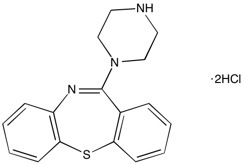Norquetiapine 2HCl | Quetiapine metabolite
NMR (Conforms)

Available Options
| Size : | Price | Quantity | |
|---|---|---|---|
| 50 mg | $60.00 | ||
| 250 mg | $240.00 |
Norquetiapine 2HCl (111974-74-4) is a pharmacologically active metabolite of quetiapine (Seroquel).1 Exhibits distinct pharmacological activity from quetiapine and plays an important role in its antidepressant activity.2 Activates ERK1/2 and induces release of BDNF in C6 glioma cells which may contribute to the antidepressant properties of quetiapine.3 Inhibits the norepinephrine transporter which may contribute to the antipsychotic activity of quetiapine.4
References/Citations:
1) Altamura et al. (2012), Effect of quetiapine and norquetiapine on anxiety and depression in major psychoses using a pharmacokinetic approach: a prospective observational study; Clin. Drug Investig., 32 213
2) Lopez Munoz and Alamo (2013), Active metabolites as antidepressant drugs: the role of norquetiapine in the mechanism of action of quetiapine in the treatment of mood disorders; Front. Psychiatry, 4 102
3) Di. Benedetto et al. (2012), N-desalkylquetiapine activates ERK1/2 to induce GDNF release in C6 glioma cells: a putative cellular mechanism for quetiapine as antidepressant; Neuropharmacology, 62 209
4) Bjorkholm et al. (2013), Role of concomitant inhibition of the norepinephrine transporter for the antipsychotic effect of quetiapine; Eur. Neuropsychopharmacol., 23 709
NMR (Conforms)
Safety Data Sheet:
Product Data Sheet:
Materials provided by Focus Biomolecules are for laboratory research use only and are not intended for human or veterinary applications. Please note that we do not sell to individuals and that all orders placed by non-research organizations will incur a $20 restocking/refund fee
Norquetiapine 2HCl (111974-74-4) is a pharmacologically active metabolite of quetiapine (Seroquel).1 Exhibits distinct pharmacological activity from quetiapine and plays an important role in its antidepressant activity.2 Activates ERK1/2 and induces release of BDNF in C6 glioma cells which may contribute to the antidepressant properties of quetiapine.3 Inhibits the norepinephrine transporter which may contribute to the antipsychotic activity of quetiapine.4
References/Citations:
1) Altamura et al. (2012), Effect of quetiapine and norquetiapine on anxiety and depression in major psychoses using a pharmacokinetic approach: a prospective observational study; Clin. Drug Investig., 32 213
2) Lopez Munoz and Alamo (2013), Active metabolites as antidepressant drugs: the role of norquetiapine in the mechanism of action of quetiapine in the treatment of mood disorders; Front. Psychiatry, 4 102
3) Di. Benedetto et al. (2012), N-desalkylquetiapine activates ERK1/2 to induce GDNF release in C6 glioma cells: a putative cellular mechanism for quetiapine as antidepressant; Neuropharmacology, 62 209
4) Bjorkholm et al. (2013), Role of concomitant inhibition of the norepinephrine transporter for the antipsychotic effect of quetiapine; Eur. Neuropsychopharmacol., 23 709
Calculate the molar concentration, mass or volume in a solution.
Concentration × Volume × Molecular Weight = Mass
Focus Biomolecules • Plymouth Meeting, PA USA • 1-855-FOCUS21
Focus Biomolecules
Plymouth Meeting, PA USA
1-855-FOCUS21
Website Created by Advanta Advertising LLC.

